Lea Wait's Blog, page 57
August 25, 2023
Writer Beware by Kait Carson
 It takes a long time to write a book. The time between inspiration and publication often spans years. This can be a problem for writers who sprinkle their books with identifiable locations. Places change, buildings fall, natural disasters occur, wars erupt, nothing remains the same in life.
It takes a long time to write a book. The time between inspiration and publication often spans years. This can be a problem for writers who sprinkle their books with identifiable locations. Places change, buildings fall, natural disasters occur, wars erupt, nothing remains the same in life.
DEATH DIVE, my newest book, is releasing on September 19th. The Blue Hole of Belize is a featured player. I originally wrote the book in 2016 as the third of the Hayden Kent series. My publisher ceased operations. The book never appeared. I put it on the digital shelf, and life went on.
Fast forward to 2023. After much soul-searching, I decided Hayden Kent, the book’s protagonist, wasn’t done with me. I dusted off the book, sent it to my editor, and prepared for a final read through. My file filled with notes of story facts to check and issues to resolve. I am familiar with the Blue Hole dive, at least the top one hundred thirty feet of it. The Hole itself is roughly four hundred feet deep. Well beyond the capability of recreational divers.

Belize Blue Hole Photo licensed through DepositPhotos
When I wrote the book, no one had been to the bottom of the Hole. The facts as written were correct in 2016. In 2018, an expedition made a submersible dive to the bottom. The dive was live-streamed, but the reports were not published until late 2019, when the world’s attention turned toward the budding pandemic. The exploration significantly changed our understanding of conditions at the bottom. DEATH DIVE needed to be updated. Fortunately, the premise survived the new information, but some scenes needed significant revision.
Some books face issues that cannot be resolved in revision. In June, author Elizabeth Gilbert removed her latest book, SNOW FOREST, from publication out of respect for her Ukrainian readers. The book, three years in the writing and scheduled for release in early 2024, featured a Russian setting. The decision has drawn both kudos and criticism. Few authors operate at her level on the world stage. This raises the question of how many other books were silently abandoned before publication because of current events.
The decision to include a real-life location in a novel is akin to casting it in amber. The writer trusts it will always exist, if not forever, at least long enough to make it to the book’s debut. This isn’t always the case, and the author faces three options: revise, rescind, or relinquish the story.
August 24, 2023
Mainely Wicked: Following the Characters by Matt Cost
I would like to start with a disclaimer. Mainely Wicked was hi-jacked by the baddies.
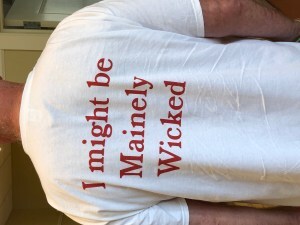

My books always start with an idea. The inspiration for Mainely Wicked was the notion of the scariness of dating sites. Two people getting together based upon online conversation and pictures to get to know each other better, possibly intimately. That, coupled with the fact that there are some scary individuals out there creates a connection that could easily lead to terror. Or something WICKED.

The first four of my Mainely Mystery series have a bit of the three Fs. Fighting, foul language, and fornication. But just a hint, enough to be real but not overwhelm. Langdon, Chabal, and crew, meander their way through the pages trying to unravel the mysteries involving nuclear power plants, vandalism during ice storms, rich lobbyists, private mercenaries, and find abducted children.
But the baddies in Mainely Wicked led us down a much darker path. Through no fault of mine, it turned out they were the descendants of a missionary group, or grotto, of the Church of Satan. A cavern of evil so filthy that they were expelled from the Church of Satan. And what could cause that to happen? Well, you see, they eat people. Or the leader, the self-proclaimed wendigo does, anyway. The Wendigo has an insatiable appetite for human flesh.
You see how this was not my fault?

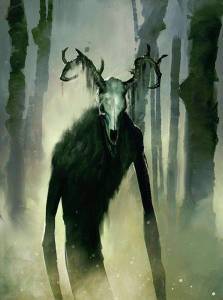
A study done at the Edinburg Literary Festival by John Foxwell in the English Department of Durham University in the U.K. shows that many authors hear the voices of their characters. According to his survey, 63% of authors hear voices of their characters and 42% can enter into dialogue with them. Further, 65% of author’s characters can act on their own accord. Some authors even claim that characters give them unsolicited advice on their own lives.
This is my problem.

I have become close enough friends with Langdon, Chabal, 4 by Four, Bart, Richam, and Jewell so that they rarely surprise me anymore. But when you introduce baddies who are using dating sites for nefarious purposes, they might, and did, take you down a dark and WICKED road.
My mysteries are most certainly character driven AND led. I come up with an idea and turn it over to Goff Langdon, Clay Wolfe, or 8 Ballo and let them take it wherever it goes. I am often surprised, but never in such an abominable way as the baddies took me in Mainely Wicked.
How about your, readers and writers? Do the characters speak to you? Do you talk back, either internally or externally? Do they surprise you? Do you consider them friends and enemies? Let me know.
Write on.
About the Author
Matt Cost was a history major at Trinity College. He owned a mystery bookstore, a video store, and a gym, before serving a ten-year sentence as a junior high school teacher. In 2014 he was released and began writing. And that’s what he does. He writes histories and mysteries.
Cost has published five books in the Mainely Mystery series, with the fifth, Mainely Wicked, just released in August of 2023. He has also published four books in the Clay Wolfe Trap series, with the fifth, Pirate Trap, due out in December of 2023.
For historical novels, Cost has published At Every Hazard and its sequel, Love in a Time of Hate, as well as I am Cuba. In April of 2023, Cost combined his love of histories and mysteries into a historical PI mystery set in 1923 Brooklyn, Velma Gone Awry. City Gone Askew will follow in April of 2024.
Cost now lives in Brunswick, Maine, with his wife, Harper. There are four grown children: Brittany, Pearson, Miranda, and Ryan. A chocolate Lab and a basset hound round out the mix. He now spends his days at the computer, writing.
August 22, 2023
If your writing is stuck, shake things up!
Most writers sometimes hit a wall partway through a manuscript.
That said, I don’t believe in writer’s block, and I don’t think you do, either. I think of it more as writer’s detour. It can happen even when you have an idea of where you want things to go, or even when you have an outline.
Calling it writer’s block makes it easy to close the laptop and walk away until inspiration hits.
Don’t do it! The longer you stay away from the book, the less it’s going to be in your head. There are better ways to solve the problem.
I’ve learned some tricks over the years to get things back on track. They may work for you or may not. If they do, great. If they don’t, they may give you some ideas of what would work for you. The point is that instead of waiting for inspiration, shake things up and make it happen.
I recently bought a fairly cheesey journal-type thing called “Write a Novel From Nothing.” (Sorry if you’re the inventor of this. My adjectives are totally subjective and it’s an awesome journal.) It has a lot of elements, including pages that ask questions to develop characters, plot, setting, etc. Even though my book isn’t at the “nothing” stage (far from it), the excercises helped. Once you’ve been working on a book for a while, it’s easy to forget things, even important ones like character motivation and plot-driving setting elements. Being prompted with exercises may be all you need.Re-start from the beginning. Everyone has a different writing process, but almost any process can benefit from going back to the beginning if you’re stuck at a certain point. Rewriting key early scenes can help move the plot in directions you didn’t see before.Get a whiteboard, chalkboard, anything, and go through the manuscript and outline what’s going on. Write out themes and where they happen in the book and make charts of plot progression, etc. Whatever works for you. I don’t generally outline before I start, though I do have some general idea of what’s going to happen. But as I go, I outline, reoutline, figure out where the lulls and action are, etc. I even do a calendar to help keep timeline things straight. At some point late in the process, like I am now, I erase the whole whiteboard and go back to the beginning of the book and start the process over, which helps me see where scenes should and shouldn’t be, etc. No, it’s not pretty, but it can give you a mile-high look at the book. That perspective may help loosen things up.
You can’t have too many whiteboard outlines. Well, maybe you can. But you get what I’m saying. Putting a manuscript into perspective may help you get unstuck.
Re-read (or read) a really good favorite author whose books are nothing like yours. have trouble reading books in my genre when I’m in the thick of writing. It makes me think too much about my own book, but not in a good way. It’s like I’m looking in a funhouse mirror, and causes a lot of anxiety about the fact that my own book isn’t done. Hard to totally explain, and probably a blog post for another day. The point is, though, that I often overdo it and avoid reading any fiction, but stick to nonfiction (I have dual Northern Ireland Troubles and Mount Everest Disaster obsessions going on right now). Nonfiction is great, too, but we’re talking about moving a stuck manuscript forward, and nonfiction usually doesn’t help (except for plot points maybe). I recently broke my rule, though, and read Kate Atkinson’s “Shrines of Gaiety” (five stars!). Then I re-read another of her books. Then another. Her writing style is complicated and awesome, and it made me start thinking of ways I can loosen things up a little, not just with style, but with plot and characters. Once you think about doing that, it changes the way you look at the book. At least it did for me.Free your mind. Similar to the previous point — sometimes when you spend a lot of time with a manuscript you begin to paint yourself into corners and stop seeing possibilities. Consider plot, characters and action and ask yourself “Do these have to be this way?” Usually when you’re stuck it’s because something isn’t working. Reconsidering even small things like some aspect of a character’s personality, or a geographical layout, or adding or taking away a minor character can spur a bigger change.Take a major detour and write character biographies. I know! Ugh! I always feel that if I’m going to be writing, I want it to be the actual book. But this is an excercise that can move that book forward. It’s kind of an expanded version of the one-page character descriptions in the journal I mentioned at the top. Sometimes all it takes is a more in-depth knowledge of a character to understand what he or she is going to do next.Keep writing even if it’s nonsense and you don’t feel like it’s moving your story forward. Have your characters have inane conversations or go to a ballgame or anything else that won’t make it into the book. Write a scene where your character sees a famous actor in the grocery store. These are just random things — you don’t have to specifically write these scenes. But write anything, even if you can’t think of what to write next that’ll actually stay in your book. I promise you that something in your brain will loosen up and you’ll be back on track. It may seem like “wasted writing,” but if it gets you where you want to go, it’s not.Don’t worry about the “shoulds” and “should nots.” This can be paralyzing when you’re writing. There’ll be plenty of time to revise, rewrite, fix, change, dump, etc. Get to the end of the draft without worrying too much about all the things you should and shouldn’t be doing. The only voice in your head should be yours and your characters’. Once you have the story down, then it’s time to fix it and make it right. I know it’s a lot of work, but that’s what writing is.I hope this was helpful. I know everyone writes differently. But I think all of us at times get stuck, not only on the writing part but what to do about getting stuck on the writing part. We get concerned about following certain “rules,” or feel like we already know our characters and plot and just want to get on with it.
But if you’re stuck, you’re stuck. You need to get unstuck. Find a way to shake things up that works for you.
Happy writing!
August 21, 2023
Sea Books
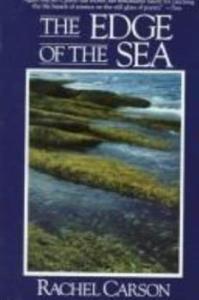 Charlene
D’Avanzo:
Charlene
D’Avanzo:
In The Edge Of The Sea Rachel Carson tells us that “the edge of the sea is a strange and wonderful place” – and I couldn’t agree more. Carson focuses on plants and invertebrates that live between lowest and highest tides from Newfoundland to the Florida Keys. It is a book meant to be read for practical identification or pure pleasure – not easy to pull off. First published in 1955, The Edge Of The Sea is still a best seller. One reviewer calls Carson’s prose “hauntingly beautiful”.
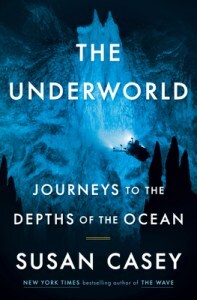 Susan Casey’s The Underworld: Journeys to the Depths of the Ocean takes readers on a deep-sea global tour – from myths of ancient worlds, deep storied shipwrecks we can now reach, and scientists trying to understand the mind-blowing complexity and ecological importance of quadrillions of creatures who live in realms long thought to be devoid of life. Along the way we learn about increasing threats from climate change, industrial fishing, pollution, and mining companies exploring the depths. A glorious tribute to nature, this is also a weighty call to arms.
Susan Casey’s The Underworld: Journeys to the Depths of the Ocean takes readers on a deep-sea global tour – from myths of ancient worlds, deep storied shipwrecks we can now reach, and scientists trying to understand the mind-blowing complexity and ecological importance of quadrillions of creatures who live in realms long thought to be devoid of life. Along the way we learn about increasing threats from climate change, industrial fishing, pollution, and mining companies exploring the depths. A glorious tribute to nature, this is also a weighty call to arms.
In The Ecology of Deep-Sea Hydrothermal Vents marine biologist Cindy Van Dover tells the story of hidden magical worlds featuring giant clams, tubeworms, and eyeless shrimp – deep-sea hot-water springs found along sea-floor spreading rifts discovered in 1977. Van Dover is the first and only woman to pilot the Alvin, one of the first deep-sea submersibles.
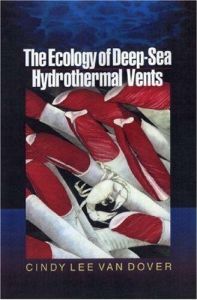 I was a grad student at the Marine Biological Laboratory, up the street from the Woods Hole Oceanographic Institute (WHOI), Alvin’s home base and remember the excitement it created. In Alvin scientists study plate tectonics, hydrothermal vents, discover strange sea life — and even explored the RMS Titanic in 1986 after WHOI scientist Bob Ballard located the famed shipwreck. The submersible also helped the Navy locate a missing hydrogen bomb from World War II.
I was a grad student at the Marine Biological Laboratory, up the street from the Woods Hole Oceanographic Institute (WHOI), Alvin’s home base and remember the excitement it created. In Alvin scientists study plate tectonics, hydrothermal vents, discover strange sea life — and even explored the RMS Titanic in 1986 after WHOI scientist Bob Ballard located the famed shipwreck. The submersible also helped the Navy locate a missing hydrogen bomb from World War II.
August 18, 2023
Weekend Update: August 19-20, 2023
 Next week at Maine Crime Writers there will posts by Charlene D’Avanzo (Monday), Maureen Milliken (Tuesday), Matt Cost (Thursday), and Kait Carson (Friday).
Next week at Maine Crime Writers there will posts by Charlene D’Avanzo (Monday), Maureen Milliken (Tuesday), Matt Cost (Thursday), and Kait Carson (Friday).
In the news department, here’s what’s happening with some of us who blog regularly at Maine Crime Writers:
An invitation to readers of this blog: Do you have news relating to Maine, Crime, or Writing? We’d love to hear from you. Just comment below to share.
And a reminder: If your library, school, or organization is looking for a speaker, we are often available to talk about the writing process, research, where we get our ideas, and other mysteries of the business, along with the very popular “Making a Mystery” with audience participation, and “Casting Call: How We Staff Our Mysteries.” We also do programs on Zoom. Contact Kate Flora
August 17, 2023
The Mystery of Cranium 17
Forgive the rerun, folks; it’s been a very nutty summer. I still smile at the memory of this conversation. The pictures seem to have gone the way of all things.
I was on a plane recently (something I’ve spent far too much time doing lately) and got into the usual conversation with a seatmate.
“What do you do?” he said.
“I’m a writer.”
“What do you write? Anything I would have read?”
“Crime fiction, mostly. Murder mysteries.”
“Oh, I can’t read those. All the violence just makes me sick.”
Aside from the disheartening sense that we weren’t going to have anything else to talk about for the rest of the twelve-hour flight, it did set me thinking why, with all the actual violence in the world, I was engaged in creating stories where violence was such a central component. Was I, in effect, just adding more violence into a world already surfeited with it? And, if so, how could I justify that?
The earliest written tale we have is the Babylonian epic Gilgamesh, created over 3000 years ago. Incised on the twelve clay tablets, among paeans to the beauty of the king of Uruk and episodes of droit du seigneur, is an ode to violence, from the first fight between Gilgamesh and Enkidu to their mutual quests, in which various monsters, animal guardians, and gods are attacked and/or dispatched. So at least we’re working out of some sort of tradition. Violent stories are as old as writing. As is murder, apparently.
In 2015, field researchers found a 430,000 year old skull in the Atapuerca Mountains in Northern Spain, at the bottom of a 40 foot pit.
This skull, catchily named Cranium 17, was different from all the other skull bones in the pit because it showed two holes in the forehead, just above the left eye. CT scans and forensic analysis demonstrated that the skull’s owner died from these wounds and that the positions and angles of the impacts indicated that the blows were struck, not incurred in a fall. That is, the person whose skull this was was murdered. Nearly half a million years ago, we were killing each other.
So do we accept that violence is an inherent part of being human?
I suspect one of the reasons crime writers are drawn to violence is that we recognize the violent tendencies in ourselves, in all of us. Even the mildest mannered rage in traffic, flare when someone angers them, curse an unlucky break. By creating situations and characters that partake of violence, sometimes in extreme forms, are we sublimating our own violent tendencies? Or bleeding off that emotion somehow?
Or maybe we write about it so we can experience it, indulge it, vicariously. Maybe we are voyeurs of an experience we don’t want for ourselves but are avid to see, to understand, to show to others.
My belief is that senseless violence frightens us most. When the trigger is a perverted interpretation of a religious impulse we do not empathize with or the pure evil of a psychopathic personality that we cannot comprehend, we shy from it. But by writing about it, we can certainly try to understand.
But the interest for me in writing about crime and violence, as it is for most interesting writers, I think, is the why of the violence, not the who or the what. Descriptions of fistfights, gun battles, car chases, even torture, get boring very quickly. But the human pressures, the emotions, acts, or desires that provoke someone into the violent act? We all want to know the causes, root and immediate, that sling the punch, that fire the gun.
What I wish I’d answered to my interlocutor was this: my writer’s interest in violence is motive, which is to say character. I write my stories to find out not what happened but why. Is this every writer’s motive? I would never suggest that. But I believe it’s part of why we choose to write what we do.
And seriously. Wouldn’t you like to know why Cranium 17 was murdered? And by whom? Solve a murder mystery half a million years old?
August 16, 2023
Paying Attention To Flowers And Stones, And …
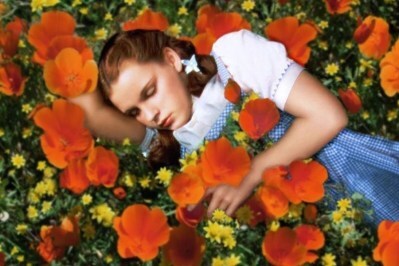
WHO DOESN’T LOVE FLOWERS? (Dorothy in poppies; Wizard of Oz)
Sandra Neily here: Sharing a wildflower fiesta with readers. I’m sharing many (but not all) of the flowers I found in a one hour walk in uncut fields at the ski area north of Greenville.








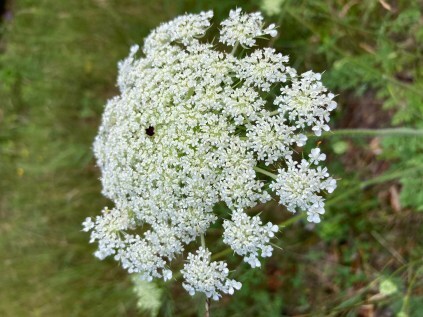







Reven just thinks anything that grows under her belly and butt is comfy.

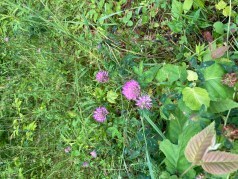

The last week of July seems to be the moment when some early flowers are still here, and new ones are just coming along. Everywhere I turned there were blooms and blossoms. (Names: black-eyed Susan, vetch, bladder campion, golden rod, queen Anne’s lace, yarrow, butter cups, yellow primrose, St. Johns wort, mountain ash, blueberry, purple loosestrife (do not plant this; very invasive), clover, crown vetch)
And of course, Many Oliver comes to us with her message of attending to the world in small quiet ways. Maybe flower by flower, stone by stone.
Praying by Mary Oliver
It doesn’t have to be
the blue iris, it could be
weeds in a vacant lot, or a few
small stones; just
pay attention, then patch
a few words together and don’t try
to make them elaborate, this isn’t
a contest but the doorway
into thanks, and a silence in which
another voice may speak.
— from Thirst
I haven’t identified these. Know them? (A North Carolina stream ate some of my ID programs when my phone slipped into it.) 

Sandy’s debut novel, “Deadly Trespass, A Mystery in Maine” won a national Mystery Writers of America award, was a finalist in the Women’s Fiction Writers Association “Rising Star” contest, and was a finalist for a Maine Literary Award. 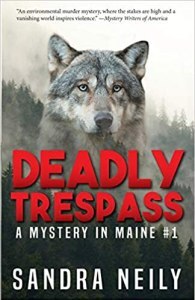 The second Mystery in Maine, “Deadly Turn,” was published in 2021. Her third “Deadly” is due out in 2023. Find her novels at all Shermans Books (Maine) and on Amazon. Find more info on Sandy’s website.
The second Mystery in Maine, “Deadly Turn,” was published in 2021. Her third “Deadly” is due out in 2023. Find her novels at all Shermans Books (Maine) and on Amazon. Find more info on Sandy’s website.
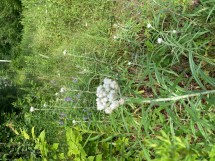
pearly everlastings announce summers last days
August 14, 2023
The Bluebird of Happiness?
Kate Flora: As I frequently encourage the rest of you to be, I’ve tried to be more attuned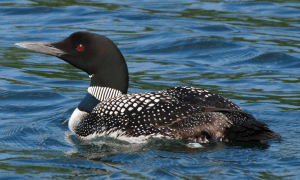 to the world around me lately. The habit of getting up, staggering to the kitchen, and making coffee which I drink while reading the news is hard to break, though. As is what follows–sitting down at my laptop and starting to work. And there’s my “I’m stuck and don’t know where to go next” activity, which is browsing shoes on eBay. I used to joke that you could tell how the writing was going by how many pairs of shoes I’d bought recently.
to the world around me lately. The habit of getting up, staggering to the kitchen, and making coffee which I drink while reading the news is hard to break, though. As is what follows–sitting down at my laptop and starting to work. And there’s my “I’m stuck and don’t know where to go next” activity, which is browsing shoes on eBay. I used to joke that you could tell how the writing was going by how many pairs of shoes I’d bought recently.
Well…those of you in New England, remember that insanely heavy rain last week? The one that washed down the street and poured mud and rocks into my driveway? Well, it also washed a pair of shoes, dropped off by one of those casual delivery guys who just dumped in the driveway, into the middle of the lawn. When I found it, those shoes were soaking wet. Perhaps this is a message from the universe to STOP BUYING SHOES?
But this is supposed to be about bluebirds, right? Or paying attention? Well, to help me pay attention, I’ve got the Cornell Merlin app on my phone. I rarely see the birds but I often hear them, and so I’m gradually getting better at grabbing the phone and going out into the yard to let it listen with me. A week ago, there was a very odd new bird sound, one I thought was some kind of hawk, so phone and I dashed outside to listen. Phone said–and this made me laugh–that it was a merlin. https://merlin.allaboutbirds.org
 Then, a few days later, another, and different sound, and the bird flew past so fast I couldn’t get a good look at it. But it wasn’t a shy and retiring type, and Merlin said it was a Cooper’s Hawk. I don’t remember all these hawks being around before, but perhaps Merlin is just tuning up my senses.
Then, a few days later, another, and different sound, and the bird flew past so fast I couldn’t get a good look at it. But it wasn’t a shy and retiring type, and Merlin said it was a Cooper’s Hawk. I don’t remember all these hawks being around before, but perhaps Merlin is just tuning up my senses.
That’s not all the avian world is offering this summer. There’s a loon on the cove, returned early from inland where I understand they go to breed. There are wispy little hummingbirds visiting my flowers. And biggest treat of all, bluebirds dashing to and fro eating berries from the bush below the porch. A few days earlier, I had said we ought to cut those bushes back because they in the way–the bushes, not the bluebird–but thank goodness we didn’t get to it. What a wonderful treat to sit and watch those amazing flashes of blue.
Next door, there were a pair of mallards hunkered down below my neighbor’s bird feeder.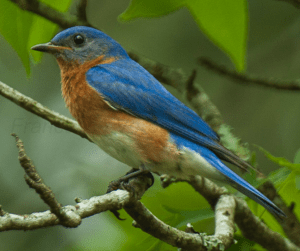 A flock of six turkeys have a regular route through our property and sometimes roost in the trees. The baby Eiders are almost grown and the Eiders are massing as they did in the spring. Stately groups of Canada Geese travel in flotillas up and down the cove.
A flock of six turkeys have a regular route through our property and sometimes roost in the trees. The baby Eiders are almost grown and the Eiders are massing as they did in the spring. Stately groups of Canada Geese travel in flotillas up and down the cove.
This isn’t just a lazy day activity. Paying attention to the world around us gives us so much. Knowing about the flora and fauna can make our writing much more vivid and help our readers to feel located in a particular, rather than generic place. Spending time, as we authors do in summer, at book fairs and art and culture events gives us an ever-changing panoply of characters. How they look, how they walk, how they dress, the endless variety of colored hair and tattoos. Who makes eye contact and who looks away? How couple behave together. Who will be the first to declare: I don’t read.
Merlin can’t help with that, of course. There isn’t an app to ID people, but Merlin can remind us to pay attention. To collect images and sounds and scents for our writing or simply for our pleasure at being in the world.
A reminder about our Body Contest. Please share with your friends:
Yes, friends, it’s back: Our “Where Would You Put the Body?” contest
It’s Maine Crime Writers “Where Would You Put the Body?” contest – late summer/early fall edition. How do you enter? Send a photograph of your chosen spot to: WritingAboutCrime@gmail.com with “Where Would You Put the Body?” in the subject line. There will be prizes for First, Second, and Third place–books of course and other Maine goodies. You may enter no more than three photographs, each one entered separately. They must be of Maine places and you must identify the place in your submission. Photos must be the submitter’s original work. Contest will run through the middle of October.
August 13, 2023
Weeding
Kaitlyn Dunnett/Kathy Lynn Emerson here, assuming you’re tired of hearing about the new book (Death of an Intelligence Gatherer, just in case you’ve forgotten). Don’t worry, I’ll plug that one and others again. In the meantime, I thought I’d bring you up to date on what else I’ve been up to.
First you have to understand that I’m a compulsive saver with a deeply ingrained distrust of the permanence of electronic copies. That said, it won’t surprise you that I tend to print copies of just about everything—e-mails, drafts of works-in-progress, photocopies of pages from books borrowed on Inter-Library loan, copies of online articles on topics I needed to research, manuscripts to proofread or read for a blurb. You get the picture.
For those who worry about saving the trees—not as big a problem in Maine as elsewhere—I mitigate the negative aspects of making so many printouts by printing as much as possible on the backs of printed pages I no longer need to keep. Only when both sides have been used does anything go in the recycled paper bin at the dump.

file cabinet now filled ONLY with files on individual writing projects
Every time I’ve weeded my research files, I’ve ended up with a stack of one-side-blank paper. I still had more to weed when I made arrangements to donate numerous items in my “author estate” to the Maine Women Writers Collection at the University of New England. (See the blog I wrote a few months ago on that subject by clicking here: https://mainecrimewriters.com/2023/05/15/your-heirs-will-thank-you/ ). This advance planning meant I needed to go through everything relevant to inventory what the donation will include and where various items are located (so my heirs can find them!). “Everything” included a mass of paperwork. Now that I’m not writing any new books in my two series or any more historical novels, I no longer need all those folders full of notes on random subjects as varied as Celtic weddings, pythons, and travel times in the 16th century. I hadn’t even glanced at most of them for years. They were just taking up space.
 Among the 8½”x11″ pages still available to be relegated to the “recycle at the dump” or “recycle to use the back” piles were research, copies of old e-mails, cover letters to editors from the days when I copy edits were exchanged by snail mail, and multiple printouts of manuscripts at various stages in their creation. There’s no point in keeping all the versions of every book, not even under the guise of an author estate. A couple of examples of how a book evolves should suffice.
Among the 8½”x11″ pages still available to be relegated to the “recycle at the dump” or “recycle to use the back” piles were research, copies of old e-mails, cover letters to editors from the days when I copy edits were exchanged by snail mail, and multiple printouts of manuscripts at various stages in their creation. There’s no point in keeping all the versions of every book, not even under the guise of an author estate. A couple of examples of how a book evolves should suffice.
At the end of the inventory process, I had a new stack of pages with blank sides sitting next to my printer. It was well over a foot high. The photo shows only part of the pile, about a third of what accumulated. The rest has been moved into one of the file drawers. Thanks to all my weeding, I actually ended up with a bit of empty storage space.
Question for folks reading this: am I the only one who still prints out everything I might need to refer back to? For the record, I make multiple electronic back-ups, too, although I will never be able to bring myself to completely trust “the cloud.”

Kathy Lynn Emerson’s newest book is Death of an Intelligence Gatherer. As Kathy, and as Kaitlyn Dunnett, she has had sixty-four books traditionally published and has self published others. She won the Agatha Award and was an Anthony and Macavity finalist for best mystery nonfiction of 2008 for How to Write Killer Historical Mysteries and was an Agatha Award finalist in 2015 in the best mystery short story category. In 2023 she won the Lea Wait Award for “excellence and achievement” from the Maine Writers and Publishers Alliance. She was the Malice Domestic Guest of Honor in 2014. She is currently working on creating new omnibus e-book editions of her backlist titles. Her website is www.KathyLynnEmerson.com.
August 11, 2023
Weekend Update: August 12-13, 2023
 Next week at Maine Crime Writers there will posts by Kaitlyn Dunnett/Kathy Lynn Emerson (Monday), Kate Flora (Tuesday), Sandra Neily (Thursday), and Dick Cass (Friday).
Next week at Maine Crime Writers there will posts by Kaitlyn Dunnett/Kathy Lynn Emerson (Monday), Kate Flora (Tuesday), Sandra Neily (Thursday), and Dick Cass (Friday).
In the news department, here’s what’s happening with some of us who blog regularly at Maine Crime Writers:
Matt Cost just published the fifth book in his Mainely Mystery series, Mainely Wicked. Langdon is hired to find a man who answered a classified ad and then disappeared into thin air. And then a second person vanishes. What starts as a couple of simple missing-person cases quickly spirals into a diabolical world of witches, wiccans, and wendigos.
Cost will be at the Readfield Community Library on August 16th speaking of his recent release, Mainely Wicked. The event is from 6:30 to whenever it ends. “Langdon faces his most WICKED case yet, and not everyone will survive. When Chabal is taken, the chase takes Langdon to a climactic scene on an island in the middle of Maranacook Lake outside of Readfield…”
On Friday, August 18th, Cost will be the 3rd Friday Bath Art Hop from 4-7 p.m. No hopping necessary but books will be signed.
Matt and fellow MCW writers Jule Selbo, Dick Cass, Maureen Milliken, Vaughn Hardacker, and John Clark at the Topsham Library Maine Authors Fair last Saturday


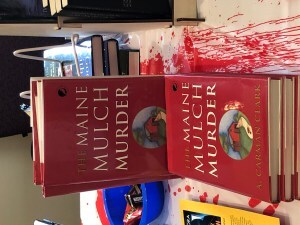


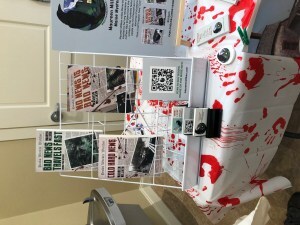
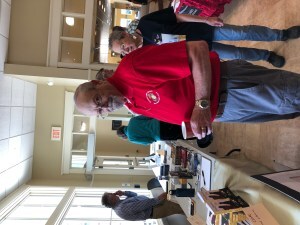
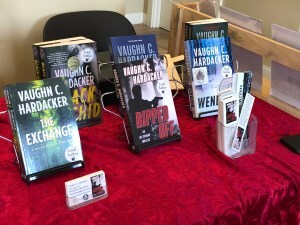

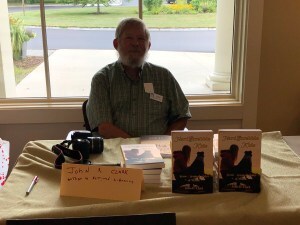
A reminder about our Body Contest. Please share with your friends:
Yes, friends, it’s back: Our “Where Would You Put the Body?” contest
It’s Maine Crime Writers “Where Would You Put the Body?” contest – late summer/early fall edition. How do you enter? Send a photograph of your chosen spot to: WritingAboutCrime@gmail.com with “Where Would You Put the Body?” in the subject line. There will be prizes for First, Second, and Third place–books of course and other Maine goodies. You may enter no more than three photographs, each one entered separately. They must be of Maine places and you must identify the place in your submission. Photos must be the submitter’s original work. Contest will run through the middle of October.
An invitation to readers of this blog: Do you have news relating to Maine, Crime, or Writing? We’d love to hear from you. Just comment below to share.
And a reminder: If your library, school, or organization is looking for a speaker, we are often available to talk about the writing process, research, where we get our ideas, and other mysteries of the business, along with the very popular “Making a Mystery” with audience participation, and “Casting Call: How We Staff Our Mysteries.” We also do programs on Zoom. Contact Kate Flora
Lea Wait's Blog
- Lea Wait's profile
- 509 followers



